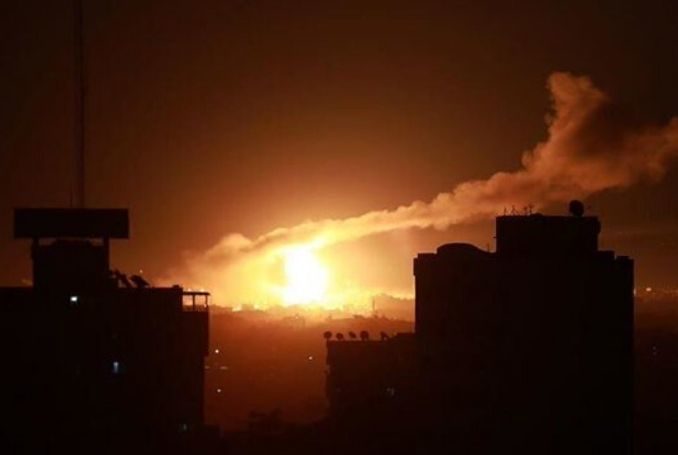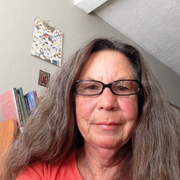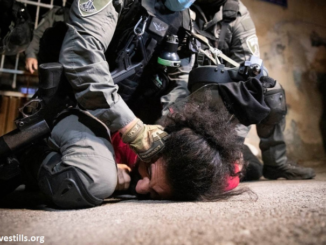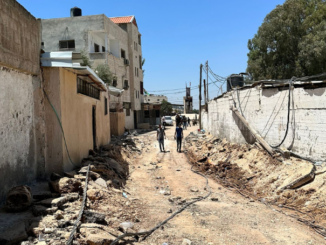
By Benay Blend
“California fires are like the ongoing attacks on Gaza,” writes Palestinian author Ibtisam Barakat. “So one is natural and the other unnatural…Both are overwhelming and make one stop to wonder how people on Earth need to have a conversation about protecting lives and living for everyone.”
Here in New Mexico, we are also seeing smoke from fires just north of Santa Fe. Barakat ties all of these disasters together by calling for a universal dialogue that would highlight the need to heal all manner of wrongs done to humanity and the Earth.
What unites these fires, too, from Gaza to the American Southwest, is the colonization and consequent mismanagement of Indigenous land. In America for centuries, and in Occupied Palestine since 1948, colonizers have wiped out the Indigenous presence by genocide and land appropriation. In the process, they have also refused to honor traditional practices that managed fire in a responsible way.
In Colonization, Fire Suppression, and Indigenous Resurgence in the Face of Climate Change, Kari Marie Norgaard (non-Native professor of sociology and environmental studies at University of Oregon) relates that the “130-year legacy of fire suppression in the U.S. is a process that continues to dispossess Native peoples of their lands.”
Indeed, the Karuk tribe of the mid-Klamath River region in Northern California have traditionally used low-intensity burning as an “ecosystem process and restoration technique.” Replaced by non-Native management practices, new systems have led to serious ecological changes that make such serious fires that are happening now more frequently.
According to the Karuk Climate Change Adaption Plan, increasing incidence of “high severity fire” indicates the “need to re-examine human relationships with fire.”
In Australia, too, for centuries, the Indigenous people have managed the land with fire. Known as “cultural burns,” writes Gary Nunn, these fires purposefully destroyed kindling and leaf debris so that bushfires had less fuel to burn.
In The Fire Next Time (1963), James Baldwin writes of what it meant to be a Black man in America at mid-century, but his words are still relevant today. If we don’t work together, he warns, to end the racism that has become America, then next time, there will be fire.
It seems that in many ways that time has come. But, like Baldwin said, there are choices.
Fire can be used for destruction, as it has been done by Israel time and time again, the latest being the thirteen-day siege of Gaza, now perhaps 14 days as Gaza-based journalist Wafaa Aludaini just reported that Israel is once again bombing her homeland.
Added to this are the repeated times that Israelis have burned Palestinian crops, sprayed fields with poison, destroyed olive trees—ostensibly because it’s a way to destroy the people’s livelihood while also erasing any evidence of their connection to the land.
In commemoration of Land Day 2018 in Palestine, Houssem Ben Lazreg and Tesbih Habbal explain that attachment to land is a characteristic among Indigenous people, so what unites the Palestinians, First Nations of Canada and Turtle Island, is the rupture of that connection due to colonization.
Given their behavior, Israelis do not understand the logic of Australian “country,” the ways that the Indigenous of that country value the Earth much more than the structures that are built upon it. In all of the above examples, the problems stem from colonization, and the cure will always be resistance.
Fire can be just as much a symbol of defiance as destruction. Indeed, Baldwin predicted the uprisings that would occur in ‘60s, and by extension in the present, too. There would be no water, he said, to put out the fire next time if there is still no justice.
In “Tending the Fires: From a Cop Car to a Precinct, What Burns Next?” Lou Cornum writes:
“The lands there are at the crossroads of America’s never complete project to extinguish the rowdy spirit of the African, Black, Dakota, and Ojibwe generations and all others stolen and stolen from. Minneapolis historically and today is also a gathering place for the explosive potential of the movements made against racist colonial violence.”
He continues: “In the totality of the fire, from the markings left in ashes to the shape of shooting flames, are the forces that transform history into prophecy.” In conclusion, he asks, like Baldwin did so many years before, what burns next?
In Gaza, incendiary balloons are “distress signals,” claim Muhammad Shehada and Walid Mahmoud, an effort to force Israel to lift the disastrous blockade. For the past several weeks the Barq (Lightning Unit) has set up camp close to Gaza’s border. From there they launch incendiary balloons in the direction of empty areas nearby in Israel.
“We came here to send a fiery message to the Israeli occupation that we in the Gaza Strip can no longer tolerate the blockade that’s been taking place for 13 years,” explains Abu Yousef, the Unit’s spokesman.
“We would like to send a message that we deserve a decent life to our families and loved ones,” he added.
In response, Israel has launched a series of nightly bombing raids while cutting off fuel imports needed to power electricity.
On Aug. 6, 2020, another fire erupted closer to my home as flames destroyed the historic Ojo bathhouse along with the remains of Ojito, the sacred pool, used for healing by Indigenous elders and their families.
Purchased in 1932 by Frank S. Mauro Sr., the Ojo Caliente Mineral Springs remained accessible to the Tewa (current Eight Northern Pueblos) for the last 75 years. His granddaughter, Mary Jo Mauro, relates that after a hostile stock takeover around 2000, the agreement became null and void on July 1 of this year. At that time, the new managers erected dirt berm to block community members from entering what had long been their sacred waters.
Not long after, fire gutted the structure, perhaps in response to the disrespect paid its rightful caretakers who were barred from entering their land. It is Mauro’s hope that in the rebuilding, the Indigenous Tewa descendants will have their waters returned to them in an “accessible, sacred and honorable way.”
As wildfires engulf the American Southwest, and bombs continue to fall on Gaza, Ibtisam Barakat ponders the overriding issue of our times: The manner in which “we don’t really know the nature of our planet or much of humanity.”
Therefore, for her “the only way to do anything worthwhile is to work together to heal COVID-19, to heal Gaza and Palestine, to heal California,” and the “million other things” that she feels need healing.
– Benay Blend earned her doctorate in American Studies from the University of New Mexico. Her scholarly works include Douglas Vakoch and Sam Mickey, Eds. (2017), “’Neither Homeland Nor Exile are Words’: ‘Situated Knowledge’ in the Works of Palestinian and Native American Writers”. She contributed this article to The Palestine Chronicle.

– Benay Blend earned her doctorate in American Studies from the University of New Mexico. Her scholarly works include Douglas Vakoch and Sam Mickey, Eds. (2017), “’Neither Homeland Nor Exile are Words’: ‘Situated Knowledge’ in the Works of Palestinian and Native American Writers”. She contributed this article to The Palestine Chronicle.







